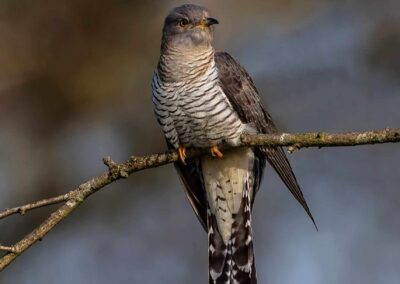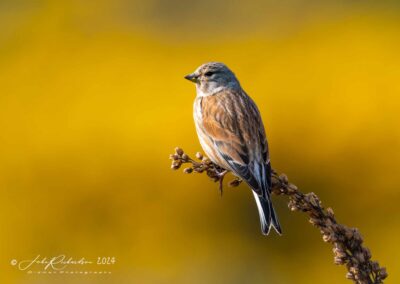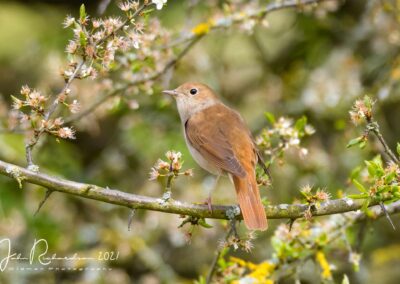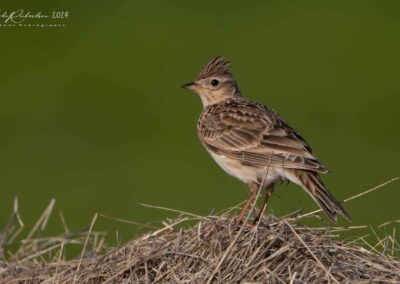5 group members, including some making their Froize debuts, met up with David Walsh and me for coffee at The Froize at the respectably early hour of 7am. We were all greeted with some wonderfully sunny weather, along with a light breeze making for some excellent weather conditions for listening to birdsong. After a brief introduction, we made our way along the sandy track running south of Chillesford.
We wandered along towards the reedbed, making several stops along the way, stopping and listening to the wonderful multiplicity of bird species in song. After a cool spring night, the males were out singing in force, they had survived another night after all! At the top of their agenda was demonstrating their fitness to other males as well as proving to nearby females that they held a productive territory with plentiful resources to raise a brood of offspring.
David Walsh led the charge, listening for and identifying birds at the front of the convoy, whilst I gave tips on birdsong to those at the rear of the group. Our aim was to pick out the songs of individual species and their characteristic melodies. A male Chaffinch sang proudly from atop nearby fir trees, ending song phrases with his closing ‘TA-DAH’ notes. We paused close to a paddock to listen to nearby songsters when the distant sound of a Cuckoo caught our attention with its repetitive disyllabic song. A pair of Linnets sat atop a gorse bush, before taking off, twittering as they flew to a nearby arable field. At our regular stopping intervals, David and I played birdsong on the Collins Bird Guide App to give the group assistance as to which sound we were focusing on.
The distant and familiar sound of a Skylark was identified by the group, but its limelight was quickly stolen by its scarcer relative. A surprise male Woodlark was hovering high up, close to an arable field margin, projecting its rich, liquid song. The group enjoyed several minutes listening to the bird, its beautiful melancholic song falling in pitch as it spiralled upwards and downwards in flight. The bird was obliging, allowing everyone the chance to see it in flight.
We wandered past a scrubby area of Hawthorn thickets, where three species of Sylvia warblers caught our attention. We picked through the songs of Blackcap, Garden Warbler and Whitethroat; with plentiful opportunities to listen to each of them. As we approached the reedbed, we heard several other warbler species singing. Reed warblers provided plenty of opportunities to study their long, rhythmic and repetitive phrases. A Sedge Warbler and Cetti’s warblers also added to the scratchy chorus, with a nearby Lesser Whitethroat and Reed Bunting also showing well.
Next to the reedbed, the Cuckoo began to sing even closer to us, and we enjoyed views of Shelduck and distant Lapwing. The morning wasn’t just about birds and listening, as several Brown Hares put on a show in a nearby field and a herd of Fallow Deer passed us at close quarters emerging out of a nearby woodland. We decided it was time to wander back, passing a lovely patch of Bluebells and a Green Woodpecker too. A group member spotted some Goldcrests in nearby conifers, which proceeded to show extremely well, allowing everyone in the group superb views of this tiny, seldom seen bird. Shortly before our 9am arrival back at The Froize we picked out a couple of House Martins. We had seen and heard 40 species, prompting discussion over an excellent breakfast, at the end of a productive and enjoyable start to the day.
As is the norm, a Froize breakfast is well worth getting up early for! Hearty, delicious and full of locally sourced ingredients – we were well sated!
After breakfast, it was time to travel in convoy, to Bromeswell Green Nature Reserve. As soon as we parked up and car doors were opened, the explosive song of Nightingales filled our ears. We counted four singing males which had set up territories and enjoyed wonderful views of a showy male sitting out in the open for a couple of minutes. His rufous feathers caught the late morning light as he sang from an exposed Hazel branch. I had brought my parabolic microphone along for this part of the morning. This device collects and amplifies the sound waves, focusing on the sound in a specific direction. It intensified the volume of the Nightingales complex melodies, directing the notes into the sensitive microphone at the focal point of the parabolic dish. All group members were able to hear the magical song of this iconic species at very close quarters. We all stood and admired the birds in stunned silence!
We also enjoyed an ensemble of singing Thrushes as a supporting cast, with Blackbirds, Song Thrush and Mistle Thrush bolstering our species list. We also enjoyed views of Kestrel, Pied Wagtail and Grey Heron by the banks of the river Deben. After a productive morning, we decided it was time to wrap the mornings birding up, heading back to our vehicles with a very satisfying total of 50 species.
Before we went our separate ways, we discussed forthcoming events at The Froize – ‘Listening out for midsummer songsters’ on 8th June, then ‘Nightjars and other night dwellers’ on the 27th June.
HARRY READ
Guest blogger
BIRDS SPOTTED |
||
| CHILLESFORD | ||
| Common Shelduck (Tadorna tadorna) | Sedge Warbler (Acrocephalus schoenobaenus) | |
| Common Pheasant (Phasianus colchicus) | Common Reed Warbler (Acrocephalus scirpaceus) | |
| Common Woodpigeon (Columba palumbus) | Barn Swallow (Hirundo rustica) | |
| Collared Dove (Streptopelia decaocto) | Common House Martin (Delichon urbicum) | |
| Common Cuckoo (Cuculus canorus) | Common Chiffchaff (Phylloscopus collybita) | |
| Northern Lapwing (Vanellus vanellus) | Cetti’s Warbler (Cettia cetti) | |
| European Herring Gull (Larus argentatus) | Eurasian Blackcap (Sylvia atricapilla) | |
| Lesser Black-backed Gull (Larus fuscus) | Garden Warbler (Sylvia borin) | |
| Common Buzzard (Buteo buteo) | Lesser Whitethroat (Sylvia curruca) | |
| Eurasian Green Woodpecker (Picus viridis) | Common Whitethroat (Sylvia communis) | |
| Eurasian Jay (Garrulus glandarius) | Goldcrest (Regulus regulus) | |
| Common Magpie (Pica pica) | Eurasian Wren (Troglodytes troglodytes) | |
| Eurasian Jackdaw (Corvus monedula) | Eurasian Blackbird (Turdus merula) | |
| Carrion Crow (Corvus corone) | European Robin (Erithacus rubecula) | |
| Coal Tit (Periparus ater) | Dunnock (Prunella modularis) | |
| Eurasian Blue Tit (Cyanistes caeruleus) | Common Chaffinch (Fringilla coelebs) | |
| Great Tit (Parus major) | Linnet (Linaria cannabina) | |
| Woodlark (Lullula arborea) | European Goldfinch (Carduelis carduelis) | |
| Eurasian Skylark (Alauda arvensis) | Common Reed Bunting (Emberiza schoeniclus) | |
| Little Egret (Egretta garzetta) | ||
| BROMESWELL (Additional Species) | ||
| Pied Wagtail (Motacilla alba) |
Grey Heron (Ardea cinerea) |
|
| Song Thrush (Turdus philomelos) | Common Nightingale (Luscinia megarhynchos) | |
| Mute Swan (Cygnus olor) | Mistle Thrush (Turdus viscivorus) | |
| Great Spotted Woodpecker (Dendrocopos major) | Long Tailed Tit (Aegithalos caudatus) | |
| Eurasian Oystercatcher (Haematopus ostralegus) |
Mallard (Anas platyrhynchos) Bird Species Total: 50 |





